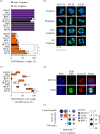The Aurora B-controlled PP1/RepoMan complex determines the spatial and temporal distribution of mitotic H2B S6 phosphorylation
- PMID: 38806145
- PMCID: PMC11293436
- DOI: 10.1098/rsob.230460
The Aurora B-controlled PP1/RepoMan complex determines the spatial and temporal distribution of mitotic H2B S6 phosphorylation
Abstract
The precise spatial and temporal control of histone phosphorylations is important for the ordered progression through the different phases of mitosis. The phosphorylation of H2B at S6 (H2B S6ph), which is crucial for chromosome segregation, reaches its maximum level during metaphase and is limited to the inner centromere. We discovered that the temporal and spatial regulation of this modification, as well as its intensity, are governed by the scaffold protein RepoMan and its associated catalytically active phosphatases, PP1α and PP1γ. Phosphatase activity is inhibited at the area of maximal H2B S6 phosphorylation at the inner centromere by site-specific Aurora B-mediated inactivation of the PP1/RepoMan complex. The motor protein Mklp2 contributes to the relocalization of Aurora B from chromatin to the mitotic spindle during anaphase, thus alleviating Aurora B-dependent repression of the PP1/RepoMan complex and enabling dephosphorylation of H2B S6. Accordingly, dysregulation of Mklp2 levels, as commonly observed in tumour cells, leads to the lack of H2B S6 dephosphorylation during early anaphase, which might contribute to chromosomal instability.
Keywords: centromere; histone phosphorylation; mitosis; phosphatase scaffold.
Conflict of interest statement
We declare we have no competing interests.
Figures








Similar articles
-
Cdk1 orders mitotic events through coordination of a chromosome-associated phosphatase switch.Nat Commun. 2015 Dec 17;6:10215. doi: 10.1038/ncomms10215. Nat Commun. 2015. PMID: 26674376 Free PMC article.
-
Wip1 controls the translocation of the chromosomal passenger complex to the central spindle for faithful mitotic exit.Cell Mol Life Sci. 2021 Mar;78(6):2821-2838. doi: 10.1007/s00018-020-03665-x. Epub 2020 Oct 16. Cell Mol Life Sci. 2021. PMID: 33067654 Free PMC article.
-
Phosphorylation of PP1 Regulator Sds22 by PLK1 Ensures Accurate Chromosome Segregation.J Biol Chem. 2016 Sep 30;291(40):21123-21136. doi: 10.1074/jbc.M116.745372. Epub 2016 Aug 24. J Biol Chem. 2016. PMID: 27557660 Free PMC article.
-
Interplay between mitotic kinesins and the Aurora kinase-PP1 (protein phosphatase 1) axis.Biochem Soc Trans. 2013 Dec;41(6):1761-5. doi: 10.1042/BST20130191. Biochem Soc Trans. 2013. PMID: 24256288 Review.
-
Making the Auroras glow: regulation of Aurora A and B kinase function by interacting proteins.Curr Opin Cell Biol. 2009 Dec;21(6):796-805. doi: 10.1016/j.ceb.2009.09.008. Curr Opin Cell Biol. 2009. PMID: 19836940 Free PMC article. Review.
Cited by
-
The ABCs of the H2Bs: The histone H2B sequences, variants, and modifications.Trends Genet. 2025 Jun;41(6):506-521. doi: 10.1016/j.tig.2025.01.003. Epub 2025 Feb 20. Trends Genet. 2025. PMID: 39984351 Review.
-
Spatio-temporal requirements of Aurora kinase A in mouse oocyte meiotic spindle building.iScience. 2024 Jul 3;27(8):110451. doi: 10.1016/j.isci.2024.110451. eCollection 2024 Aug 16. iScience. 2024. PMID: 39081293 Free PMC article.
References
MeSH terms
Substances
LinkOut - more resources
Full Text Sources
Research Materials
Miscellaneous

